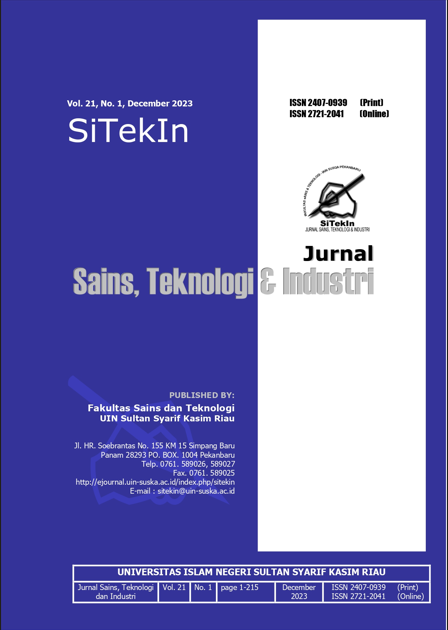Dynamic Analysis of a Prey Predator Model with Holling-Type III Functional Response and Anti-Predator Behavior
DOI:
https://doi.org/10.24014/sitekin.v21i1.23024Abstract
The prey-predator model in this article reviews the interaction of two populations with a type III Holling -type III functional response and anti-predator behavior. The dynamic analysis starts by determining the basic model construction assumptions, equilibrium and stability points, and numerical simulations using Python. Dynamic analysis results obtained four equilibrium points with types of stability, namely. which is unstable, which is asymptotically stable , and . Which is stable under certain conditions. The numerical simulation results show double stability at the equilibrium points. and with the anti-predator behavior parameter value . The anti-predator parameter value indicates a change in stability that is only the equilibrium point. Differences in the values of the anti-predator behavior parameters affect changes in system solutions and impact reducing predator populations.
References
R. Ekawati Ningrum, Abadi, and Y. Puji Astuti, “Model Matematika Mangsa Pemangsa Dua Spesies Dengan Fungsi Respon Holling Tipe II Dan Perilaku Anti-Pemangsa,” J. Ilm. Mat. , vol. 7, no. 2, pp. 10–14, 2019.
M. B. Gaib and W. A. Ja’a, “Analisis Kestabilan Model Interaksi Predator-Prey Dengan Fungsi Respon Monod-Haldane Dan Perilaku Anti Pemangsa,” Euler J. Ilm. Mat. Sains dan Teknol., vol. 8, no. 2, pp. 51–59, Dec. 2020, doi: 10.34312/euler.v8i2.10407.
F. Brauer and C. Castillo-Chavez, Mathematical Models in Population Biology and Epidemiology, vol. 2. Berlin: Springer, 2012.
A. J. Lotka, Elements of Physical Biology. Baltimore: Williams and Wilkins, 1925.
C. Holling, “The Functional Response of Predator to Prey Density and Its Role in Mimicry and Population Regulation,” Mem. Entomol. Soc. Canada,97, pp. 5–60, 1965.
M. Agarwal and R. Pathak, “Harvesting and Hopf Bifurcation in a Prey-Predator Model with Holling Type IV Functional Response,” Int. J. Math. Soft Comput., vol. 2, no. 1, p. 99, Jan. 2012, doi: 10.26708/ijmsc.2012.1.2.12.
J. H. P. Dawes and M. O. Souza, “A derivation of Holling’s type I, II and III functional responses in predator-prey systems,” 2013.
V. D. Goulart and R. J. Young, “Selfish behavior as an antipredator response in schooling fish?,” Anim. Behav., pp. 443–450, 2013.
C. B. Stanford, “The Influence of Chimpanze Predation on Group Size and Anti-predator Behaviour in Red Colobus Monkeys,” Anim. Behav. 49(3), pp. 577–587, 1995.
S. G. Mortoja, P. Panja, and S. K. Mondal, “Dynamics of A Predator-Prey Model with StageStructure on Both Species and Anti-Predator Behavior,” Informatics Med. Unlocked, 10, pp. 50–57, 2018.
B. Tang and Y. Xiao, “Bifurcation analysis of a predator-prey model with anti-predator behavior,” Chaos, Solitons and Fractals, vol. 70, no. 1, pp. 58–68, 2015, doi: 10.1016/j.chaos.2014.11.008.
S. Saadah, A. Jurusan Matematika, U. Negeri Surabaya, and D. Savitri, “Model Interaksi Mangsa Pemangsa Dengan Fungsi Respon Rasio Dependent Holling Tipe II Dan Perilaku Anti Pemangsa,” J. Ilm. Mat., vol. 7, no. 2, 2019.
P. Panja, S. K. Mondal, and J. Chattopadhyay, “Dynamical Effects of Anti-predator Behaviour of Adult Prey in a Predator-Prey Model with Ratio-dependent Functional Response,” 2017.
D. Savitri, “Dynamics Analysis of Anti-predator Model on Intermediate Predator with Ratio Dependent Functional Responses,” in Journal of Physics: Conference Series, Institute of Physics Publishing, Feb. 2018. doi: 10.1088/1742-6596/953/1/012201.
D. Savitri, “Numerical Study of One Prey-Two Predator Model Considering Food Addition and Anti-Predator Defense,” in E3S Web of Conferences, EDP Sciences, Dec. 2021. doi: 10.1051/e3sconf/202132806003.
S. Sirisubtawee, N. Khansai, and A. Charoenloedmongkhon, “Investigation on dynamics of an impulsive predator–prey system with generalized Holling type IV functional response and anti-predator behavior,” Adv. Differ. Equations, pp. 1–26, 2021.
Y. Tian, Y. Gao, and K. Sun, “A fishery predator-prey model with anti-predator behavior and complex dynamics induced by weighted fishing strategies,” Math. Biosci. Eng., vol. 20, no. 2, pp. 1558–1579, 2023, doi: 10.3934/mbe.2023071.
C. Edwards and D. Penney, Elemantary Differential Equations (six Edition), Six. New York: Pearson Education, Inc, 2008.
C. Y., Z. C., W. W., and J. Wang, “Dynamics of a Leslie–Gowerpredator–prey model with additive Allee effect,” Appl. Math Model., 2014.
G. Cardano, Ars Magna or The rules of Algebra. New York: Dover, 1545.
D. Purnamasari, Faisal, and N. A.J., “Kestabilan Sistem Predator-Prey Leslie,” J. Mat. Murni danTerapan, 3(2), pp. 51–59, 2009.
W. E. Boyce, R. C. Diprima, and D. B. Meade, Elementary Differential Equations and Boundary Value Problems, Eleventh. USA: John Wiley & Sons, 2017.
R. J. Iswanto, Pemodelan Matematika:aplikasi dan terapannya. Yogyakarta: Graha Ilmu, 2012.
A. R. P. Hasizyah and B. Susila, “Analisis Kestabilan Model Prey-Predator Holling Tipe III,” J. Mat. UNAND, vol. 10, no. 1, pp. 29–37, 2020.
Downloads
Published
Issue
Section
License
This work is licensed under a Creative Commons Attribution-ShareAlike 4.0 International License
Copyright Notice
An author who publishes in the SITEKIN Journal agrees to the following terms:
- Author retains the copyright and grants the journal the right of first publication of the work simultaneously licensed under the Creative Commons Attribution-ShareAlike 4.0 License that allows others to share the work with an acknowledgement of the work's authorship and initial publication in this journal
- Author is able to enter into separate, additional contractual arrangements for the non-exclusive distribution of the journal's published version of the work (e.g., post it to an institutional repository or publish it in a book) with the acknowledgement of its initial publication in this journal.
- Author is permitted and encouraged to post his/her work online (e.g., in institutional repositories or on their website) prior to and during the submission process, as it can lead to productive exchanges, as well as earlier and greater citation of the published work (See The Effect of Open Access).
Read more about the Creative Commons Attribution-ShareAlike 4.0 Licence here: https://creativecommons.org/licenses/by-sa/4.0/.

